 Nihhon Kaigun (1901-1922): Armoured Cruisers IJN Kasuga, Nisshin
Nihhon Kaigun (1901-1922): Armoured Cruisers IJN Kasuga, Nisshin
Italian-Built for an upcoming war
Kasuga class armoured cruisers. These Cruisers were part of a rapid explansion plan of the Imperial Japanese Navy prior to the 1904 war with Russia. In a short span, Japan, still lacking the industrial output to built many cruisers and capital ships at once, consented an unprecedented budgetary effort and acquired several vessels to foreign yards, “sampling” them: UK with the Asama and Idzumo classes (as well as battleships), Germany with Adzuma, France with Yakumo and Italy with the Garibaldi class: IJN Kasuga and Nisshin, ex-Italian,; ex-Argentinian, purchased on the stocks after the Pacts of May, which ended the Chile-Argentina naval arms race (they would have been named Rivadavia and Moreno). Kasuga and Nisshin took part in the Russo-Japanese war, at the battle of Yellow sea and Tsushima. Nisshin in particular showed that an armored cruiser could take part in battleship line combat and survive. They became training ships after 1920 and survived until 1948 and 1936 respectively. #ww1 #russojapanesewar #tsushima #portarthur #IJN #imperialjapanesenavy #nihhonkaigun #japanesenavy #nisshin #kasuga #garibaldi #armoredcruiser
The Garibaldi class has been designed originally to be very versatile ships not only able to perform classic cruiser duties (screening for the fleet or operating alone against commerce raiders) but also to hold the line in a fleet, being perfect intermediaries between heavy cruisers and battleships. The italian Yard also offered to built them quickly and cheaper than British, German or French Yards at the time. Which motivated Argentina in the first place to purchase them… On 10 ships of this class built, only three were for the Regia Marina seven for foreign navies, and that included one for Spain and no less than six for Argentina: ARA Garibaldi, Puyreddon…
Design Genesis
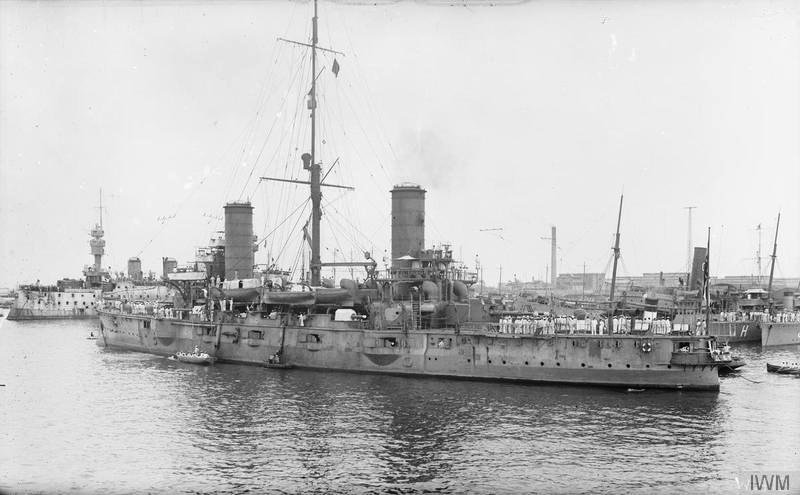
Nisshin in Port Said, Egypt, 1918 (IWM) unlike her sister she was part of a squadron escorting ships from Australian all the way trhough the Mediterranean during WWI. But she was also the most hit of admiral Togo’s fleet at Tsushima, taking no less than six 12-in caliber shells and survived. She proved that the original Italian concept of heavily armoured and armed cruisers able to fight in a battleline was sound.
The design of the Giuseppe Garibaldi-class cruisers was submitted to naval architect Edoardo Masdea known for his successful, earlier Vettor Pisani-class. He was submitted an admiralty project that was reworked by him as chief naval engineer, conducting studies following directives of the Minister of the Navy Benedetto Brin, crossed with suggestions by Ansaldo Yard commissioned to build the first ship. Brin suggested to rework the design indeed of the Vettor Pisani class in the light of new characteristics presented by St Bon class Battleships. It would have been odd to have battleships faster than cruisers…
The basic concepts behind the project were:
-Cruisers able to work as “normal” armored cruisers (commerce raiding notably) and line units, operating closely with the fleet.
-Facing enemy formations of protected cruisers, even in individual missions, and thus having heavy armament and protection.
-Being still able to out-run battleships due to a higher speed.
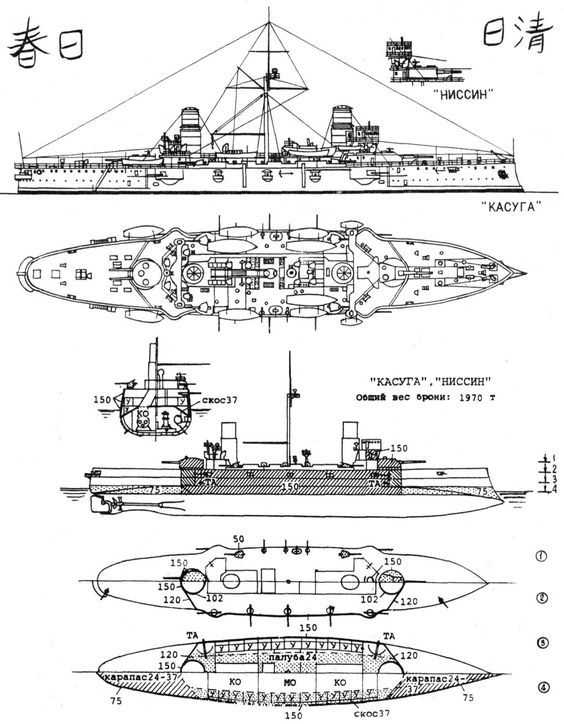
Russian publication blueprint via pinterest
In the end, Brin was confirmed in the idea that Vettor Pisani was a good starting base by Masdea, but he revised it to gain an increase in displacement, no less than 1000 tons to reach the difficult requirements, in large part the larger hull meant to accomodate a greater powerplant. The first design was deemed satisfactory on this base as everythibng match the upgraded design: Better armament, still adequate protection 20 knots as a top speed. The classic “impossible trilogy”, nightmare of all naval engineers, between armament, protection and speed for once was perfectly well balanced. The displacement also reflected this fact, with 40% of the total going to structural weight, 15% to artillery (including ammunition), 25% to the armor, 20% to the powerplant.
This new design was slightly larger, a knot faster than the Pisanis, with the improvement of two twin gun turrets fore and aft of the superstructure, which remedied the primary armament on the broadside for older ships, not able to engage targets forward and aft.
As for the Japanese order, it was the result of the impending tensions in Korea and Mandchuria with the Russian Empire from 1902 onwards. 春日 Kasuga was originally not ordered as the Argentinian Rivadavia, but purchased later, she was initially the Italian Mitra when laid down on 10.3.1902, launched on 22.10.1902. She was sold on slip and renamed. 日進 Nisshin was also originally the former Italian Roca laid down on 5/1902, purchased by Argentina as Mariano Moreno, and launched as Kasuga on 9.2.1903.
Design of the class
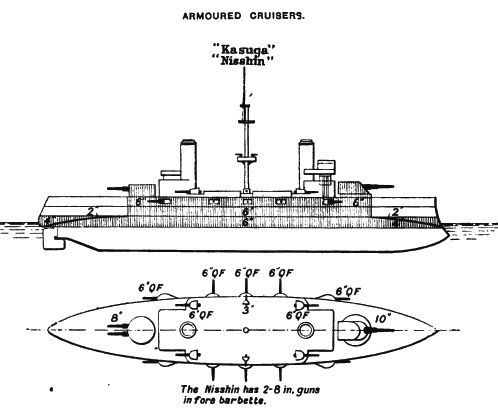
Hull and general design
The hull was continuous deck steel, with a rounded stern and high sides. The width/length ratio was very high and favored its stability both in navigation and as a shooting platform. The superstructures were almost completely symmetrical, with a stern castle and a forward one on which the command tower rose. In the central section between the two castles there were two funnels with a circular section. The rudder was of the semi-compensated type. The general architecture, reducing the superstructures to the essential minimum, decreased both the target offered to the enemy and the tonnage.
Armour protection layout
The armor used was Harvey-type case-hardened steel, making their protection above average. The process was invented by American inventor and industrialist Harvey, for the first time injecting nickel steel with carbon and thus creating a hardened alloy having the same thickness. It was way above the usual low carbon ironbacked by layers of teak wood and more flexible than usual steel which was often brittle and shattered on impact. Relative (but not sufficient) elasticity combined with high hardness made the process successful until Krupp managed to add chromium, and reduced thickness by 1/3 with added elasticity, for the same protection.
The armor of the Garibaldi class was uniform up to the deck with a 150 mm (6-in) belt reduced to 80 mm (3.6 in) at both end, a central “citadel” with 130 mm (5-in) thick cross members and a 38 mm (2-in) thick curved armoured deck above the waterline. Main turrets were shielded by 150 mm plting (6 in) and the secondary gun barbettes by 130 mm (5-in). Underwater protectionwas minimal, but still included a double bottom and heavy compartimentation. But there was little depht to prevent a warhead blast to pierce through the machinery space.
So in short:
Armoured belt: 150-70 mm
Upper belt: 150 mm
Barbettes: 150-100 mm
Main turrets: 150 mm
Casemates: 150 mm
Armoured Deck: 38-25 mm
Conning Tower (fwd): 150 mm
Powerplant
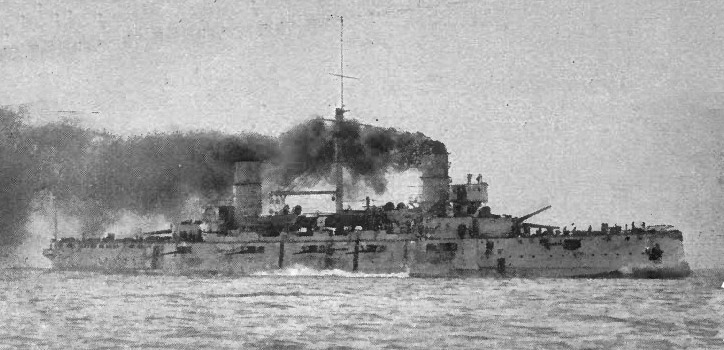
The engine was the same on all ships in the class, and the Kasuga were not exception: Two shafts (four bladed bronze propellers), driven by two triple expansion, reciprocating engines in turn fed by steam coming from 24 boilers burning coal. Machines and boilers depending on ships were provided by Ansaldo, Hawthorn, Guppy, Orlando, Belleville and Niclausse. In the case of the Kasuga class, same yard at Ansaldo, Genoa, they were naturally given Ansaldo Boilers. Diverging in tonnage and capacity, they were still credited of 20 knots on sea trials.
Both carried 13,500 tons of coal, but they diverged in capacity, Kasuga carrying 1,565 tons and Nisshin 1,316 tons of coal for 5,500 nautical miles at 10 knots economical cruise speed.
Armament
The Kasuga class had a mixed armament, IJN Kasuga diverged from her sister with her single 10-inch (254 mm) gun turret forward and one twin 8-inch (203 mm) guns aft. IJN Nisshin was more uniform with two twin turret with 8-inch (203 mm) guns fore and aft. The secondary armament was a bit more homogeneous.
Main
The armament, despite some differences between the various units, had a certain uniformity. The large caliber artillery of the Italian units consisted of one EOC 10 gun in Pattern R of 254/40 mm, which had an elevation of 35º and a weight of 30532 kg, and two EOC 8 guns in Pattern W of 203/45 mm which had an elevation of 25° and a weight of 19,356 kg.
Three Argentine ships went with two single 254 mm (10-in) guns, while ARA San Martín had four 203 mm (8-in) guns in twin turrets, Cristóbal Colón never embarked her guns.
The Kasuga class were designed to be armed as the Garibaldi, but Nisshin was armed like ARA San Martín. Guns of the Argentinian and Italian ships were manufactured in Italy at the Società degli Alti Furnaces, Foundries and Steelworks of Terni. But the Japanese had a new British standard and asked for replacement by British guns, Armstrong R for the 10-in ordnance on IJN Kasuga and 203mm/45 Armstrong W for the aft turret and both from Nisshin.
Secondary
This ranged from 10 to 14 single 152 mm (6 in) guns in the class but was the same on both Japanese vessel: IJN Kasuga like Nisshin had fourteen 40 caliber Armstrong Z pattern guns and no single 120 mm (4.7 in) guns at all for the sake of standardization. This caliber was well provisioned by British made shells, with local production at Kure arsenal underway.
Designed back in 1888 and entering Service by 1892 each weighted 6.6 tons with an overall lenght of 249.25 in (6.331 m) bore 240.0 in (6.096 m) and Chamber Volume of 832 in3 (13.63 dm3).
Rate Of Fire was 5-7 rounds per minute. They could fire either the 100 lbs. (45.3 kg) CPC, HE with the best propellant charge being the 29.75 lbs. (13.49 kg) EXE. This provided a range of 10,000 yards (9,140 m) at 15° elevation. The casemates had a 150° traverse either side.
Tertiary
Like other ships of the class they had a mix of single 76 mm (3 in), single 47 mm (1.9 in) guns and machine guns. In that case:
-Ten 76mm/40 Armstrong N
-Four 47mm/40 3pdr Hotchkiss QF Mk I.
-Two Vickers water-cooled 7.7mm/87 machine guns (that could be dismounted for a landing party).
Torpedo Tubes
They received four single 450 mm (17.7 in) torpedo tubes installed in two broadside either side, underwater. They likely fire the common Whitehead model at the time in Japan.
Later in their career they were modernized, and in 1922, both saw the removal of all ten seocndary guns as well as six of their 3-in/40 guns for their new role.
In 1924, IJN Kasuga lost six 47mm/40 Hotchkiss but gained one 76mm/40 3-shiki AA gun and her sister Nisshin four Hotchkiss and the same.
⚙ specifications |
|
| Displacement | 7,628/7,698t standard, 8,500 t FL for both |
| Dimensions | 111.7m x 18.9 x 7.32m (366 ft 7 in x 62 x 24 ft) |
| Propulsion | 2 shafts VTE, 24 Boilers 13,500 ihp (10,100 kW) |
| Speed | 20 knots (37 km/h; 23 mph) |
| Range | 5,500 nmi (10,200 km; 6,300 mi) at 10 knots (19 km/h; 12 mph) |
| Armament | 1x 10-in +1×2 or 2×2 8-in, 14x 6-in, 10x 3-in mm, 4x 3pdr, 4x 17.7 in TTs. |
| Armor | Belt 70-150, CT 150, turrets 190, decks 100-150, barbettes 10-150 mm |
| Crew | c600 |
Links/Sources
Books
John Gardiner’s Conways all the world’s fighting ships 1860-1906, Italian section
Gardiner, Robert & Gray, Randal, eds. (1985). Conway’s All the World’s Fighting Ships: 1906–1921.
Silverstone, Paul H. (1984). Directory of the World’s Capital Ships. New York: Hippocrene Books
Sondhaus, Lawrence (2001). Naval Warfare, 1815–1914. London: Routledge.
Evans, David C.; Peattie, Mark R. (1997). Kaigun: Strategy, Tactics, and Technology in the Imperial Japanese Navy, 1887-1941. Annapolis, MD: Naval Institute Press. ISBN 0-87021-192-7.
Gardiner, Robert (editor) (2001) Steam, Steel and Shellfire, The Steam Warship 1815–1905
Howarth, Stephen (1983). The Fighting Ships of the Rising Sun: The Drama of the Imperial Japanese Navy, 1895-1945.
Jane, Fred T. (1904). The Imperial Japanese Navy. Thacker, Spink & Co.
Jentsura, Hansgeorg (1976). Warships of the Imperial Japanese Navy, 1869-1945. NIP
Kofman, V.L. Armored Cruiser Type Garibaldi, Morskaya Kollektsia 3-1995
Roberts, John (ed). (1983). ‘Warships of the world from 1860 to 1905 – Volume 2
Schencking, J. Charles (2005). Making Waves: Politics, Propaganda, And The Emergence Of The Imperial Japanese Navy, 1868-1922. Stanford University Press.
Scheina, Robert (1987). Latin America: A Naval History, 1810–1987. NIP
Yabuki, Hiraku (2009). “Britain and the Resale of Argentine Cruisers to Japan before the Russo-Japanese War”.
Links
http://www.navypedia.org/ships/japan/jap_cr_kasuga.htm
https://alchetron.com/Japanese-cruiser-Kasuga
http://www.navweaps.com/Weapons/WNBR_6-40_mk1.php
https://en.wikipedia.org/wiki/Kasuga-class_cruiser
https://forum.worldofwarships.com/topic/8170-march-10-focus-kasuga-class-armored-cruisers/
 Kasuga (1902)
Kasuga (1902)
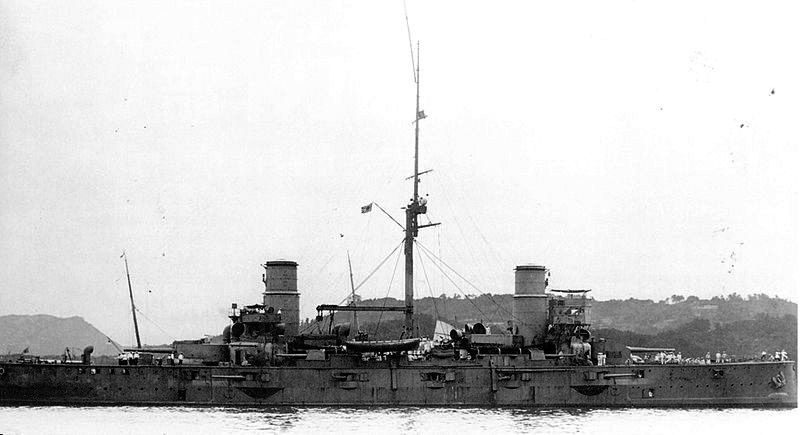
Kasuga in Sasebo, 1905
Renamed Rivadavia after launch on 22 October 1902 she was sold to Japan on 30 December 1903, renamed Kasuga (Shrine in Nara prefecture) on 1 January 1904 and formally turned over to Japan, commissioned on 7 January, the last of the Garibaldi class. She departed Genoa with her sister on 9 January under command of British captains with mixed British crews and italian stokers. In Port Said, they encountered the Russian protected cruiser Aurora (tension was ripe) transited Suez escorted by the British armored cruiser HMS King Alfred until reaching Singapore on 2 February, and reached Yokosuka on 16 February, just befire the surprise attack on Port Arthur, starting training with Japanese crews.
The Russo-Japanese war
When ready they were sent to join the battleships of the 1st Division, 1st Fleet under uner command of Admiral Tōgō Heihachirō, on 11 April. Both cruisers were ordered to lay a minefield at the mouth of the harbor on 12 April and this worked out luring part of the Russian Pacific Squadron under VADM Stepan Makarov’s flagship Petropavlovsk. His flagship under heavy fire turned back and met a mine, sinking in less than two minutes after a magazine exploded, taking most of the crew and admiral with her. Pobeda was also later damaged by a mine. Tōgō resumed long-range bombardment, with Kasuga and Nisshin contributed in blindl bombardment of Port Arthur on 15 April, anchired at Pigeon Bay, southwest side of the Peninsula from 9.5 kilometers (5.9 mi) away. They even fired in May from 18,000m (11 mi) but with very poor accuracy.
On 15 May, Yashima and Hatsuse hit Russian mines and Kasuga collided in the fog with Yoshino, capsizing, sinking with most her crew. Apart damage to her bow, Kasuga could remain active. Tōgō used then Kasuga and Nisshin in his line of battle on 23 June when the Pacific Squadron sortied again trying to reach Vladivostok under RADM Wilgelm Vitgeft, but was forced back under heavy fire again before sunset and avoiding a night battle he knew the Japanese were experts at. On 27 July, both armoured cruisers and the rest of the fleet again turned back a last sortie under desperation.
Kasuga and Nisshin next took part in the Battle of the Yellow Sea on 10 August but saw little action, at the rear of the battleline. Kasuga’s XO at the time was Kantarō Suzuki, future Japanese PM. Kasuga was hit three times and had 11 men wounded but fired 33 10-inch shells, and far more 8-inch shells with moderate results. She was later back to Pigeon Bay to resume fire on Russian fortifications, helping out Japanese infantry progress inland.
At the Battle of Tsushima on 26 May 1905, Kasuga was fifth in the battle line, opening fire at 14:10, on battleship Oslyabya, lead ship, second column of the former Baltic fleet, now second pacific fleet. Visibility was poor, compounded by heavy smoke so it’s hard to report her damage inflicted. She eventually spotted Russian ships off Liancourt Rocks, reached and shelled at 10:00, but at long-range to avoid return hits. Kasuga targeted the old Imperator Nikolai I from 9,100 meters (10,000 yd), destoryed her funnel at her third salvo, started a fire, and spotted later a white flag.
In all she spent 50x 10-inch, 103x 8-inch shells but with few confirmed hits, on Oryol (one 10-in pierced her armor of her aft 12-inch turret. Kasuga was hit in return by a 12-inch, one 6-inch, another but damage was not critical.
1906-1918
After the battle she was assigned to the 3rd Fleet and took part in the invasion of Sakhalin in July–August. On 2 September 1911 she escorted the IJN Anegawa to Vladivostok loaded with occupation troops as the port was to be kept after negociation by the Russians. In 1914, Kasuga was overhauled: Her Ansaldo coal-fired boilers were replaced by 12 Kampon Type 1 water-tube boilers burning oil, so she could have more range.
She became flagship of Destroyer Squadron Suiraisentai 3 from 13 December 1915, to 13 May 1916 but also from 12 September 1916 to 13 April 1917. When the German commerce raider SMS Wolf was signalled in the Indian Ocean by March 1917, the British Admiralty requested the IJN to patrol there as well as in Australian waters. Kasuga then escorted Allied shipping between Colombo, Ceylon and Fremantle by April–May, was based at Singapore in November. By 13 January 1918 she accidentally ran aground on a sandbank in Bangka Strait, Dutch East Indies. She stayed stuck her until June, refloated and sent for repairs in Singapore and then home.
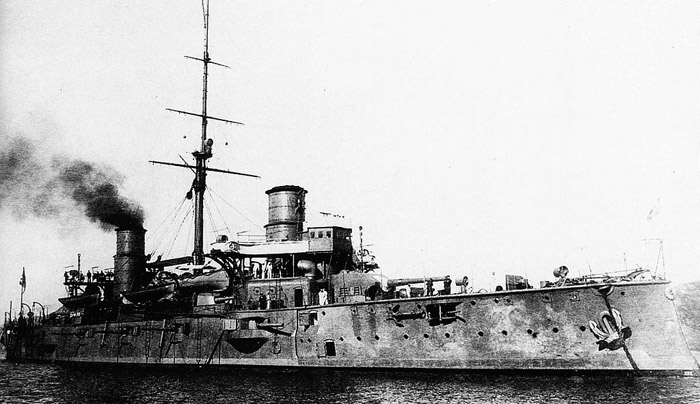
Kasuga at Kure, interwar
Interwar and World War II
Kasuga was in Portland, Maine on 3 July 1920, took part in state centennial celebrations, visited New York City and Annapolis with US cadets visiting the ship. By August 1920 she was in Cristobal Panama, after transiting the Canal on 22-25 August 1920 and was received at San Francisco. Relations with the USN were excellent at the time as a former ally.
She transported Japanese soldiers and supplies to Siberia in 1922, taking part in the Siberian Intervention for the White Russians. Kasuga under captain Mitsumasa Yonai (future PM) also launched a landing party. Fast forward an on 15 June 1926, she rescueed the crew of the British freighter SS City of Naples grounded on rocky shoals off the coast of Japan with two of her sailors being awarded silver medals for gallantry during later during the later visit of King George V. Like her sister she had armament changes in 1922-24, and was mostly used as training vessel.
She took this role permanently from 1927 to 1942, for navigators and engineers and more often at anchor in home waters. On 27 July 1928 she rescued the crew of the semi-rigid airship N3 during fleet maneuvers close to Japan. By January–February 1934, she carried 40 scientists to Truk for a total solar eclipse observation that took place on 14 February.
WW2 broke out when she was in home waters. In July 1942 she was hulked and disarmed completely, used as floating barracks until August 1945, but capsized at her mooring at Yokosuka, 18 July 1945 after hit by an air raid, but her wreck was salvaged in August 1948, BU at Uraga Dock.
 Nisshin (1903)
Nisshin (1903)
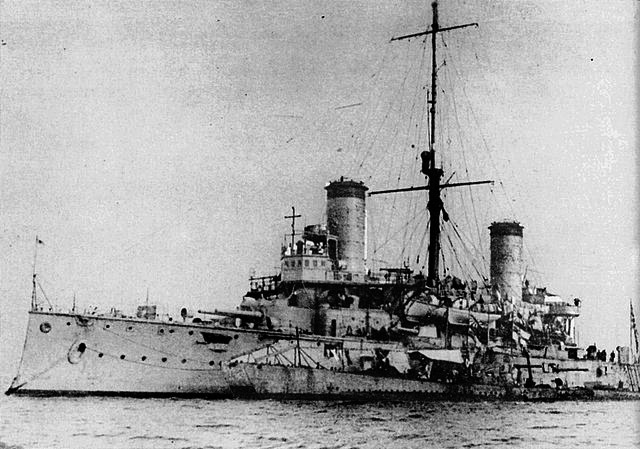
IJN Nisshin in Malta with U-Boats as war reparation to be returned to Japan, 1919.
Nisshin was the former San Roca/Mariano Moreno, sold on 30 December 1903, renamed Nisshin on 1 January 1904. She had the exact same career start as her sister. She was in Yokosuka on 16 February and started training with her new crews before being ordered to join the 1st Division, 1st Fleet.
Russo-Japanese war
At the Battle of the Yellow Sea on 10 August, Nisshin had a minor role at the rear but when changing course, was found at the head of the battleline and hit three times (14 killed, 25 wounded) before resuming bombardment from Pigeon Bay. At the Battle of Tsushima was was the flagship of Vice-Admiral Misu Sotarō, 6th and last in the line, following Kasuga. At 14:10, she started firing on Oslyabya, from 7,000 yards (6,400 m).At 14:40 she was hit by a 12-inch (305 mm) shell forward right, destroying her aft 8-inch gun and as the fleet reversed course she again became the first ship in the battle line and by 15:00, she was hot by a second 12-inch shell, which pierced her armor belt of Nisshin one foot below the waterline, flooding one coal bunker and then soon another three feet above the waterline, not penetrating. At 15:06, Zhemchug ran towards her for a torpedo attack but was driven off by her seocndary and teriary guns in a fierce display of marksmanship and speed.
The cruiser and Kasuga, Iwate close at 3,300 yards (3,000 m) to finish her off and oater as the Japanese line reversed course, again, Nisshin went at the rear, and was struck by a fourth 12-inch hit which apparently failed to penetrate and caused little damage. At 16:05, a she took a 9-inch (229 mm) shell on her forward turret, with splinters also spreading inside the conning tower, wounding the captain and staff. Nisshin was hit by a fift 12-in at 17:20 disabling her left 8-inch gun and destroyed her aft turret. At 19:00 she took a sixth and last 12-inch shell which cut her forward left 8-inch gun, so she ended with only a singe single gun forward. Later she joined the fleet spotting the Russians as Liancourt Rocks in the the following morning and she opened fire at long-range on the old Imperator Nikolai I (later captured as Iki) from 9,100 meters (10,000 yd) until the crew surrendered.
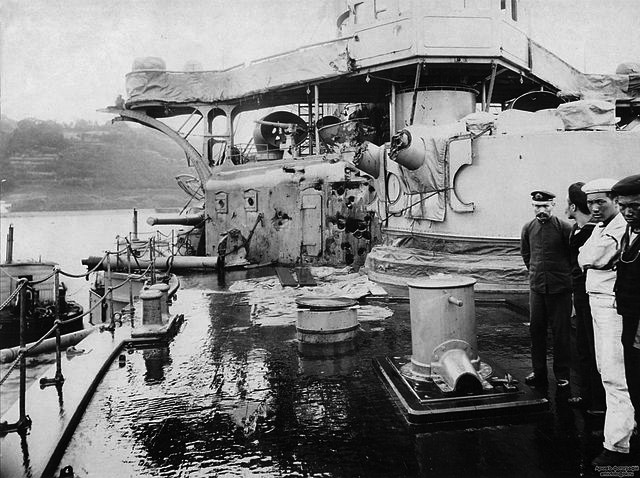
Nisshin’s forward turret and superstructure after the Battle of Tsushima
In all, she fired 181 eight-inch shells and was the most damaged after Tōgō’s flagship Mikasa (40 hits). In all she received 13 hits, including 6 twelve-inch, 1 nine-inch, 2 six-inch, 4 unidentified. Onboard was also a future IJN cadree, Ensign Isoroku Takano, which was CiC of the Combined Fleet in World War II. He was badly wounded, loosing two left hand fingers.
Postwar, Nisshin was assigned to the 3rd Fleet for the operation on Sakhalin and by 2 September 1911, she escorted the ex-Russian hospital ship, renamed Anegawa, to Vladivostok. By November 1912, she suffered a boiler explodion, killing 20. In 1914, she was overhauled like her sister with 12 Kampon Type 1 water-tube boilers.
WW1 service
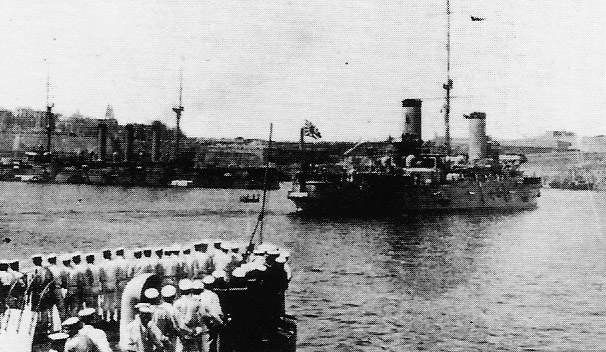
She took part during the war to the search of the German East Asia Squadron and commerce raiders at a request of the British Admiralty, from mid-September 1914. She patrolled the South Pacific but struck an uncharted rock off Sandakan on 12 October and was repatred in Singapore. She joined later the 2nd South Seas Squadron at Truk. By February 1915, she sailed to the German Samoa and German New Guinea and became flagship of Suiraisentai (destroyer squadron) 1, from 13 December 1915 to 13 May 1916 and from 12 September to 1 December 1916 as well as Suiraisentai 2 from 28 March to 13 April 1917. She also looked for SMS Wolf in Australian waters. Like her sister she escorted ships from Australia to Colombo and back.
In 1918, unlike her sister she was sent to the Mediterranean, joining the “Second Special Mission Squadron” escorted Allied troop convoys on their final leg to France or UK. By November, she became flagship of Rear Admiral Kōzō Satō and sailed to Constantinople on 6 December for the reddition ceremonies and escorted to Portland surrendered German submarines allocated to Japan, back home. They were studied in great detail and influenced the design of interwar IJN submarines, arriving home on 5 January 1919. Buy she immediately returned to Malta in March 1919 to pick some more, and was back to Yokosuka on 18 June.
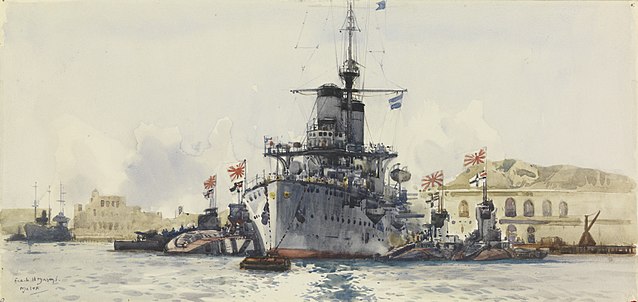
In 1924 she was rearmed as her sister, gaining an AA gun. Ad like her sister she became a training vessel and depot ship in 1927, stationed at Yokosuka. But unlike IJN Kasuga, she was stricken on 1 April 1935. Renamed Hai-Kan No. 6, she was sunk as target ship at the Kamegakubi Naval Proving Ground, off Kure, in 1936. By 18 January 1942, she was recovered and towed by the battleship Mutsu to serve again as target for the battleship Yamato off Kurahashi, Hiroshima, and sunk a second time.

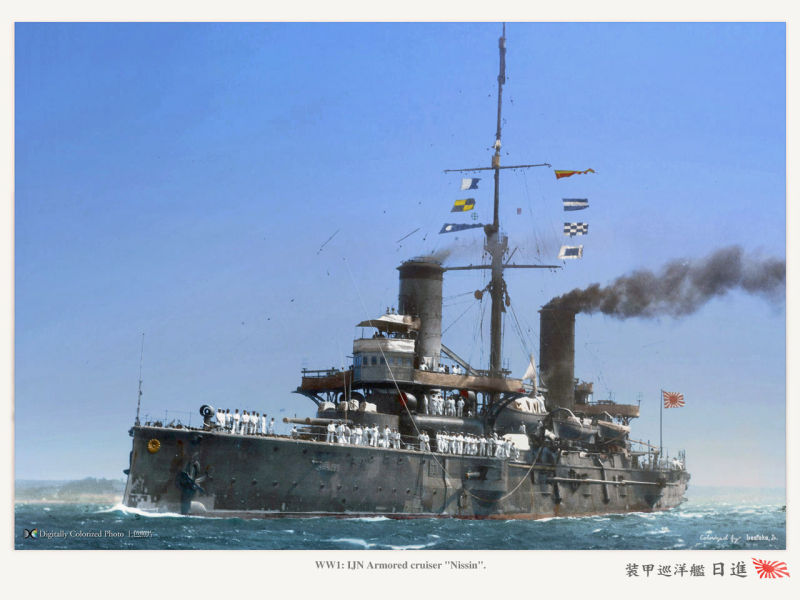
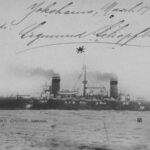

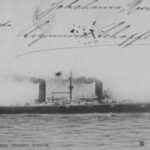
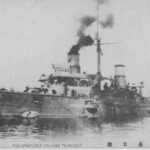
 Latest Facebook Entry -
Latest Facebook Entry -  X(Tweeter) Naval Encyclopedia's deck archive
X(Tweeter) Naval Encyclopedia's deck archive Instagram (@navalencyc)
Instagram (@navalencyc)





 French Navy
French Navy Royal Navy
Royal Navy Russian Navy
Russian Navy Armada Espanola
Armada Espanola Austrian Navy
Austrian Navy K.u.K. Kriegsmarine
K.u.K. Kriegsmarine Dansk Marine
Dansk Marine Nautiko Hellenon
Nautiko Hellenon Koninklije Marine 1870
Koninklije Marine 1870 Marinha do Brasil
Marinha do Brasil Osmanlı Donanması
Osmanlı Donanması Marina Do Peru
Marina Do Peru Marinha do Portugal
Marinha do Portugal Regia Marina 1870
Regia Marina 1870 Nihhon Kaigun 1870
Nihhon Kaigun 1870 Preußische Marine 1870
Preußische Marine 1870 Russkiy Flot 1870
Russkiy Flot 1870 Svenska marinen
Svenska marinen Søværnet
Søværnet Union Navy
Union Navy Confederate Navy
Confederate Navy Armada de Argentina
Armada de Argentina Imperial Chinese Navy
Imperial Chinese Navy Marinha do Portugal
Marinha do Portugal Mexico
Mexico Kaiserliche Marine
Kaiserliche Marine 1898 US Navy
1898 US Navy Sovietskiy Flot
Sovietskiy Flot Royal Canadian Navy
Royal Canadian Navy Royal Australian Navy
Royal Australian Navy RNZN Fleet
RNZN Fleet Chinese Navy 1937
Chinese Navy 1937 Kriegsmarine
Kriegsmarine Chilean Navy
Chilean Navy Danish Navy
Danish Navy Finnish Navy
Finnish Navy Hellenic Navy
Hellenic Navy Polish Navy
Polish Navy Romanian Navy
Romanian Navy Turkish Navy
Turkish Navy Royal Yugoslav Navy
Royal Yugoslav Navy Royal Thai Navy
Royal Thai Navy Minor Navies
Minor Navies Albania
Albania Austria
Austria Belgium
Belgium Columbia
Columbia Costa Rica
Costa Rica Cuba
Cuba Czechoslovakia
Czechoslovakia Dominican Republic
Dominican Republic Haiti
Haiti Hungary
Hungary Honduras
Honduras Estonia
Estonia Iceland
Iceland Eire
Eire Equador
Equador Iran
Iran Iraq
Iraq Latvia
Latvia Liberia
Liberia Lithuania
Lithuania Mandchukuo
Mandchukuo Morocco
Morocco Nicaragua
Nicaragua Persia
Persia San Salvador
San Salvador Sarawak
Sarawak Uruguay
Uruguay Venezuela
Venezuela Zanzibar
Zanzibar Warsaw Pact Navies
Warsaw Pact Navies Bulgaria
Bulgaria Hungary
Hungary

 Bundesmarine
Bundesmarine Dutch Navy
Dutch Navy Hellenic Navy
Hellenic Navy Marina Militare
Marina Militare Yugoslav Navy
Yugoslav Navy Chinese Navy
Chinese Navy Indian Navy
Indian Navy Indonesian Navy
Indonesian Navy JMSDF
JMSDF North Korean Navy
North Korean Navy Pakistani Navy
Pakistani Navy Philippines Navy
Philippines Navy ROKN
ROKN Rep. of Singapore Navy
Rep. of Singapore Navy Taiwanese Navy
Taiwanese Navy IDF Navy
IDF Navy Saudi Navy
Saudi Navy Royal New Zealand Navy
Royal New Zealand Navy Egyptian Navy
Egyptian Navy South African Navy
South African Navy






























 Ukrainian Navy
Ukrainian Navy dbodesign
dbodesign